Management Accounting Report: UCK Group's Financial Analysis
VerifiedAdded on 2023/03/16
|10
|2708
|76
Report
AI Summary
This report provides a comprehensive analysis of management accounting principles, focusing on costing methods, budgetary control, and financial analysis, using UCK Group as a case study. The report begins with an introduction to management accounting, emphasizing its importance for business growth and the use of effective tools and techniques. Task 1 explores costing methods, including absorption and marginal costing, with calculations and interpretations of financial data. Task 2 examines the merits and demerits of planning tools in budgetary control, analyzes expenditure, and discusses the purpose and components of a cash budget. Task 3 delves into the application of accounting systems to examine financial issues, analyzes the financial challenges faced by UCK furniture, and evaluates the planning tools used in management accounting, supported by financial ratios and interpretations. The report concludes with a summary of the findings and references.
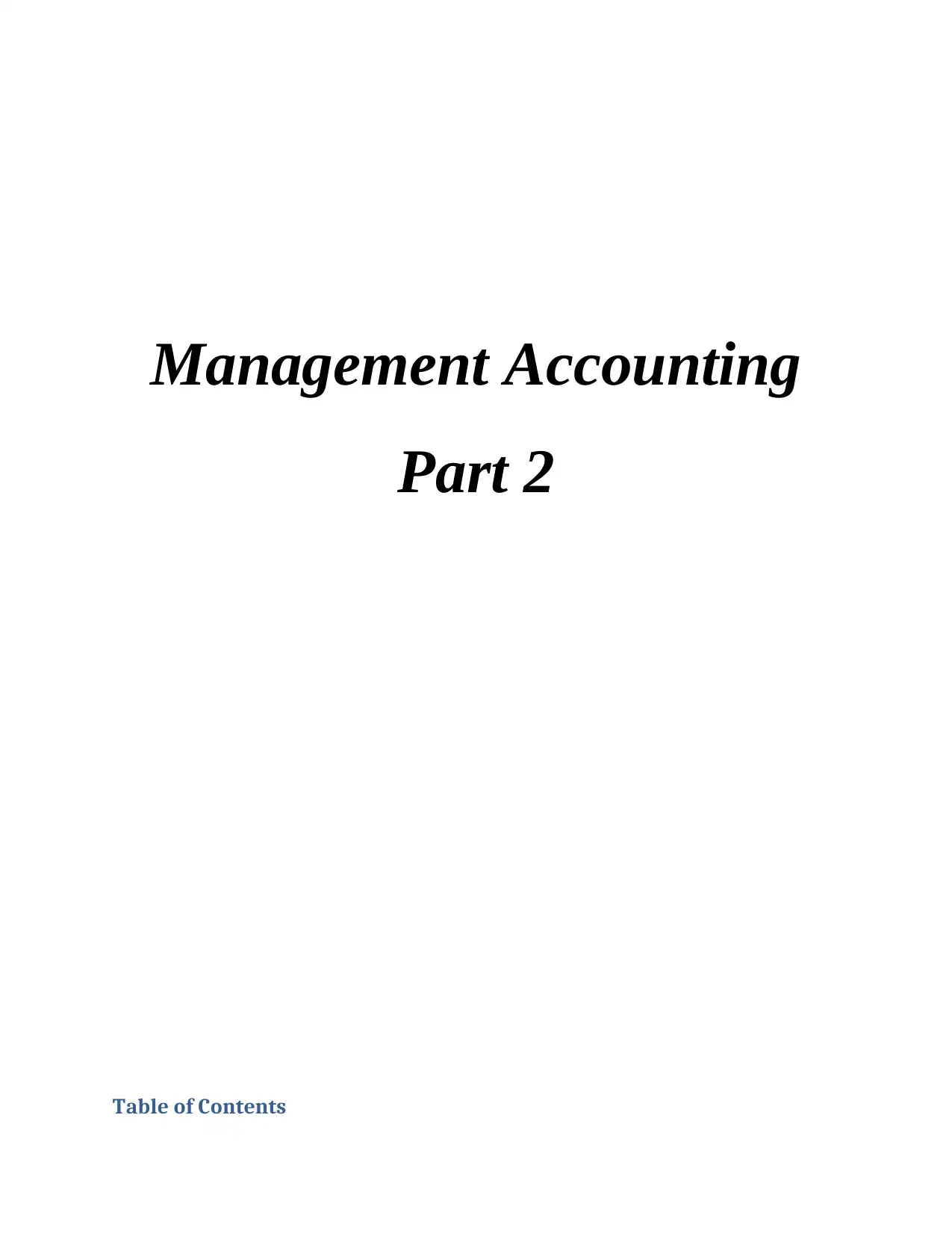
Management Accounting
Part 2
Table of Contents
Part 2
Table of Contents
Paraphrase This Document
Need a fresh take? Get an instant paraphrase of this document with our AI Paraphraser
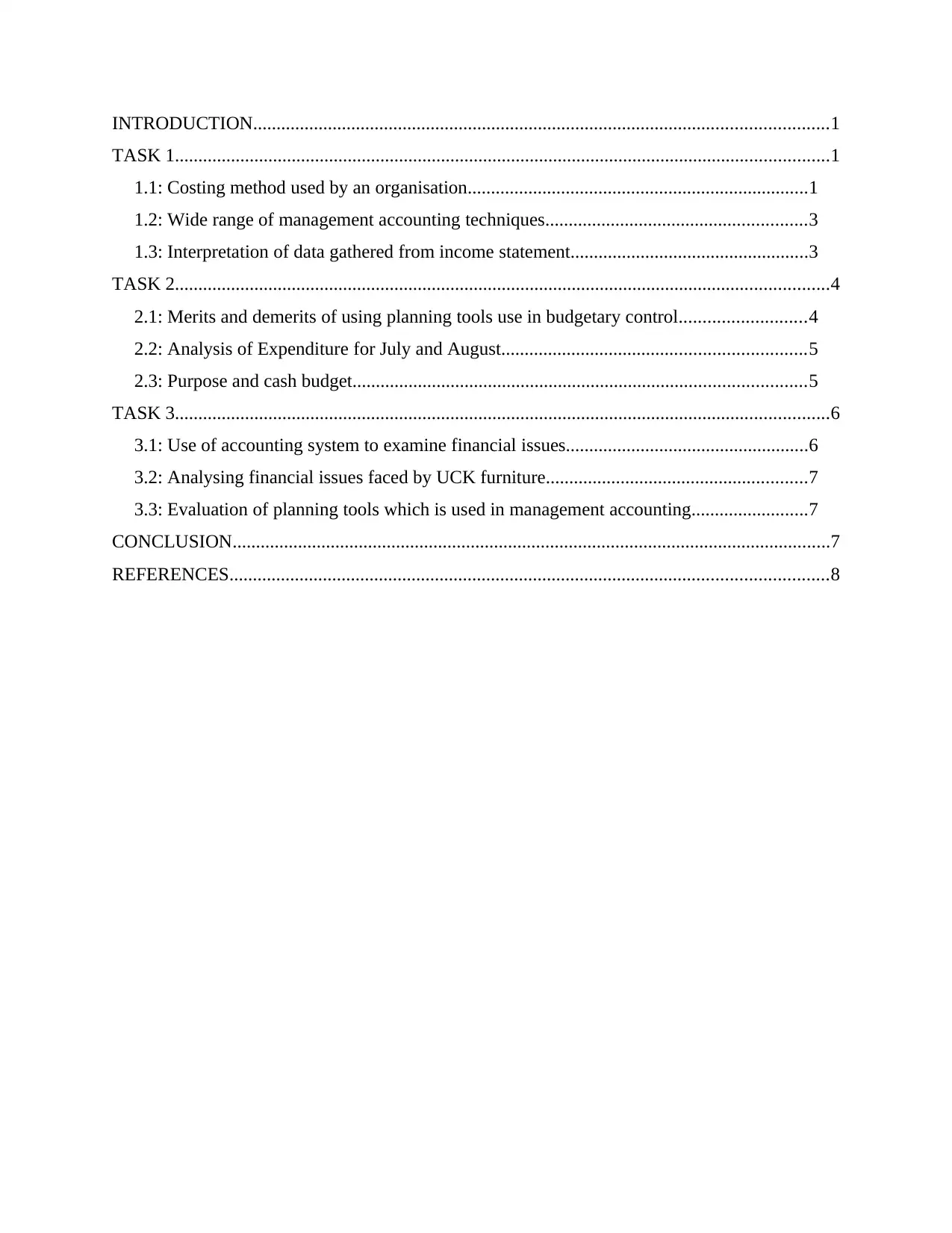
INTRODUCTION...........................................................................................................................1
TASK 1............................................................................................................................................1
1.1: Costing method used by an organisation.........................................................................1
1.2: Wide range of management accounting techniques........................................................3
1.3: Interpretation of data gathered from income statement...................................................3
TASK 2............................................................................................................................................4
2.1: Merits and demerits of using planning tools use in budgetary control...........................4
2.2: Analysis of Expenditure for July and August.................................................................5
2.3: Purpose and cash budget.................................................................................................5
TASK 3............................................................................................................................................6
3.1: Use of accounting system to examine financial issues....................................................6
3.2: Analysing financial issues faced by UCK furniture........................................................7
3.3: Evaluation of planning tools which is used in management accounting.........................7
CONCLUSION................................................................................................................................7
REFERENCES................................................................................................................................8
TASK 1............................................................................................................................................1
1.1: Costing method used by an organisation.........................................................................1
1.2: Wide range of management accounting techniques........................................................3
1.3: Interpretation of data gathered from income statement...................................................3
TASK 2............................................................................................................................................4
2.1: Merits and demerits of using planning tools use in budgetary control...........................4
2.2: Analysis of Expenditure for July and August.................................................................5
2.3: Purpose and cash budget.................................................................................................5
TASK 3............................................................................................................................................6
3.1: Use of accounting system to examine financial issues....................................................6
3.2: Analysing financial issues faced by UCK furniture........................................................7
3.3: Evaluation of planning tools which is used in management accounting.........................7
CONCLUSION................................................................................................................................7
REFERENCES................................................................................................................................8
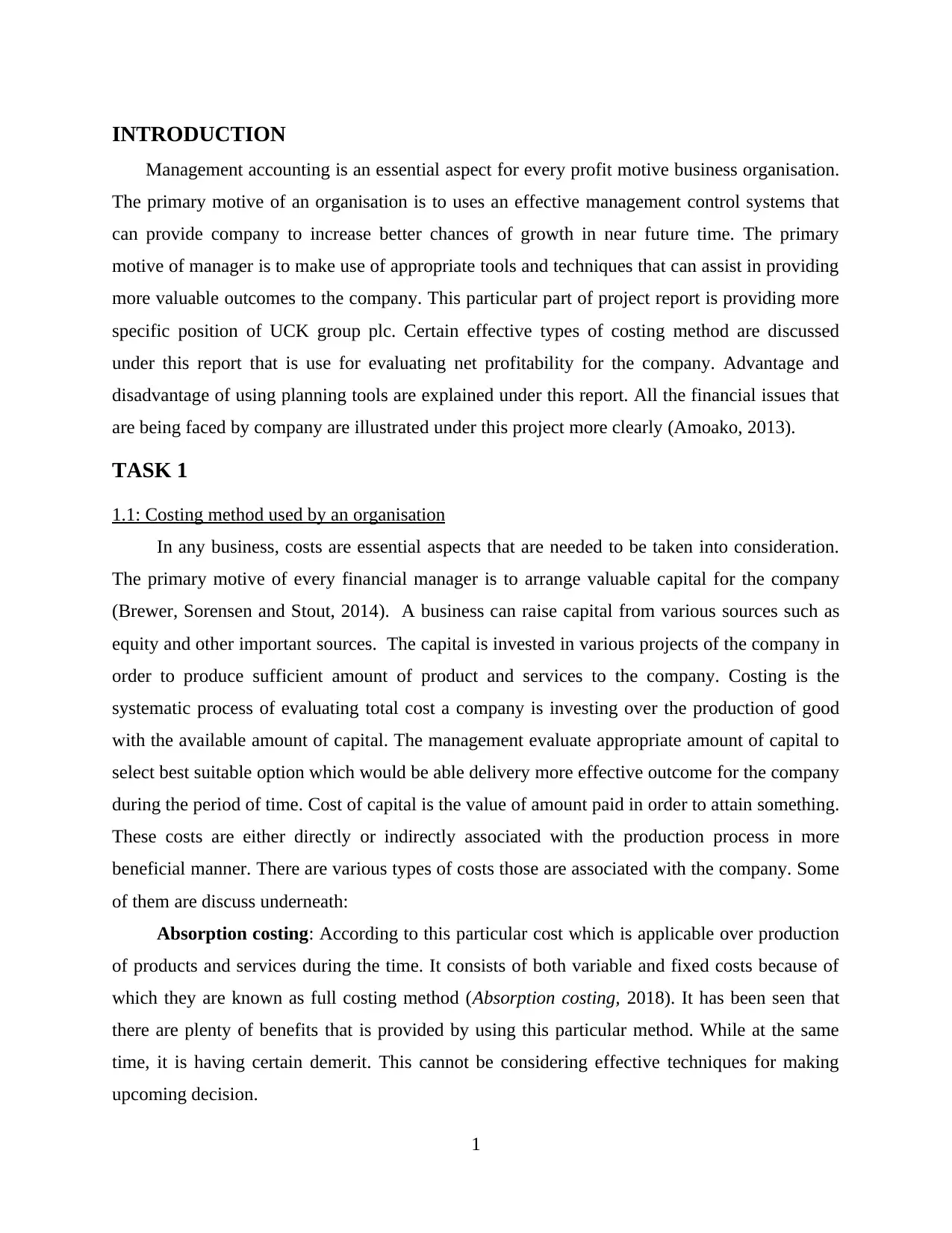
INTRODUCTION
Management accounting is an essential aspect for every profit motive business organisation.
The primary motive of an organisation is to uses an effective management control systems that
can provide company to increase better chances of growth in near future time. The primary
motive of manager is to make use of appropriate tools and techniques that can assist in providing
more valuable outcomes to the company. This particular part of project report is providing more
specific position of UCK group plc. Certain effective types of costing method are discussed
under this report that is use for evaluating net profitability for the company. Advantage and
disadvantage of using planning tools are explained under this report. All the financial issues that
are being faced by company are illustrated under this project more clearly (Amoako, 2013).
TASK 1
1.1: Costing method used by an organisation
In any business, costs are essential aspects that are needed to be taken into consideration.
The primary motive of every financial manager is to arrange valuable capital for the company
(Brewer, Sorensen and Stout, 2014). A business can raise capital from various sources such as
equity and other important sources. The capital is invested in various projects of the company in
order to produce sufficient amount of product and services to the company. Costing is the
systematic process of evaluating total cost a company is investing over the production of good
with the available amount of capital. The management evaluate appropriate amount of capital to
select best suitable option which would be able delivery more effective outcome for the company
during the period of time. Cost of capital is the value of amount paid in order to attain something.
These costs are either directly or indirectly associated with the production process in more
beneficial manner. There are various types of costs those are associated with the company. Some
of them are discuss underneath:
Absorption costing: According to this particular cost which is applicable over production
of products and services during the time. It consists of both variable and fixed costs because of
which they are known as full costing method (Absorption costing, 2018). It has been seen that
there are plenty of benefits that is provided by using this particular method. While at the same
time, it is having certain demerit. This cannot be considering effective techniques for making
upcoming decision.
1
Management accounting is an essential aspect for every profit motive business organisation.
The primary motive of an organisation is to uses an effective management control systems that
can provide company to increase better chances of growth in near future time. The primary
motive of manager is to make use of appropriate tools and techniques that can assist in providing
more valuable outcomes to the company. This particular part of project report is providing more
specific position of UCK group plc. Certain effective types of costing method are discussed
under this report that is use for evaluating net profitability for the company. Advantage and
disadvantage of using planning tools are explained under this report. All the financial issues that
are being faced by company are illustrated under this project more clearly (Amoako, 2013).
TASK 1
1.1: Costing method used by an organisation
In any business, costs are essential aspects that are needed to be taken into consideration.
The primary motive of every financial manager is to arrange valuable capital for the company
(Brewer, Sorensen and Stout, 2014). A business can raise capital from various sources such as
equity and other important sources. The capital is invested in various projects of the company in
order to produce sufficient amount of product and services to the company. Costing is the
systematic process of evaluating total cost a company is investing over the production of good
with the available amount of capital. The management evaluate appropriate amount of capital to
select best suitable option which would be able delivery more effective outcome for the company
during the period of time. Cost of capital is the value of amount paid in order to attain something.
These costs are either directly or indirectly associated with the production process in more
beneficial manner. There are various types of costs those are associated with the company. Some
of them are discuss underneath:
Absorption costing: According to this particular cost which is applicable over production
of products and services during the time. It consists of both variable and fixed costs because of
which they are known as full costing method (Absorption costing, 2018). It has been seen that
there are plenty of benefits that is provided by using this particular method. While at the same
time, it is having certain demerit. This cannot be considering effective techniques for making
upcoming decision.
1
⊘ This is a preview!⊘
Do you want full access?
Subscribe today to unlock all pages.

Trusted by 1+ million students worldwide
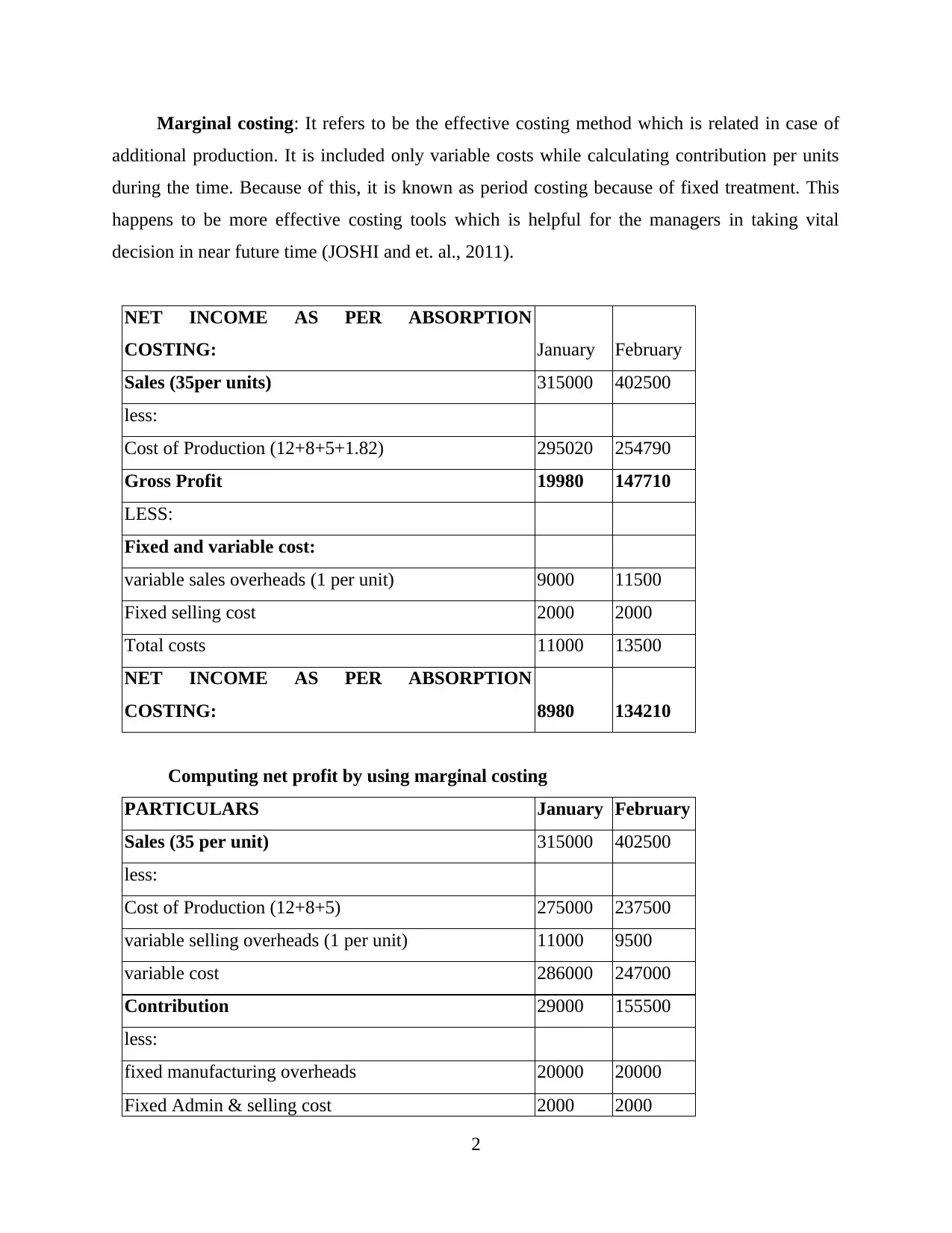
Marginal costing: It refers to be the effective costing method which is related in case of
additional production. It is included only variable costs while calculating contribution per units
during the time. Because of this, it is known as period costing because of fixed treatment. This
happens to be more effective costing tools which is helpful for the managers in taking vital
decision in near future time (JOSHI and et. al., 2011).
NET INCOME AS PER ABSORPTION
COSTING: January February
Sales (35per units) 315000 402500
less:
Cost of Production (12+8+5+1.82) 295020 254790
Gross Profit 19980 147710
LESS:
Fixed and variable cost:
variable sales overheads (1 per unit) 9000 11500
Fixed selling cost 2000 2000
Total costs 11000 13500
NET INCOME AS PER ABSORPTION
COSTING: 8980 134210
Computing net profit by using marginal costing
PARTICULARS January February
Sales (35 per unit) 315000 402500
less:
Cost of Production (12+8+5) 275000 237500
variable selling overheads (1 per unit) 11000 9500
variable cost 286000 247000
Contribution 29000 155500
less:
fixed manufacturing overheads 20000 20000
Fixed Admin & selling cost 2000 2000
2
additional production. It is included only variable costs while calculating contribution per units
during the time. Because of this, it is known as period costing because of fixed treatment. This
happens to be more effective costing tools which is helpful for the managers in taking vital
decision in near future time (JOSHI and et. al., 2011).
NET INCOME AS PER ABSORPTION
COSTING: January February
Sales (35per units) 315000 402500
less:
Cost of Production (12+8+5+1.82) 295020 254790
Gross Profit 19980 147710
LESS:
Fixed and variable cost:
variable sales overheads (1 per unit) 9000 11500
Fixed selling cost 2000 2000
Total costs 11000 13500
NET INCOME AS PER ABSORPTION
COSTING: 8980 134210
Computing net profit by using marginal costing
PARTICULARS January February
Sales (35 per unit) 315000 402500
less:
Cost of Production (12+8+5) 275000 237500
variable selling overheads (1 per unit) 11000 9500
variable cost 286000 247000
Contribution 29000 155500
less:
fixed manufacturing overheads 20000 20000
Fixed Admin & selling cost 2000 2000
2
Paraphrase This Document
Need a fresh take? Get an instant paraphrase of this document with our AI Paraphraser
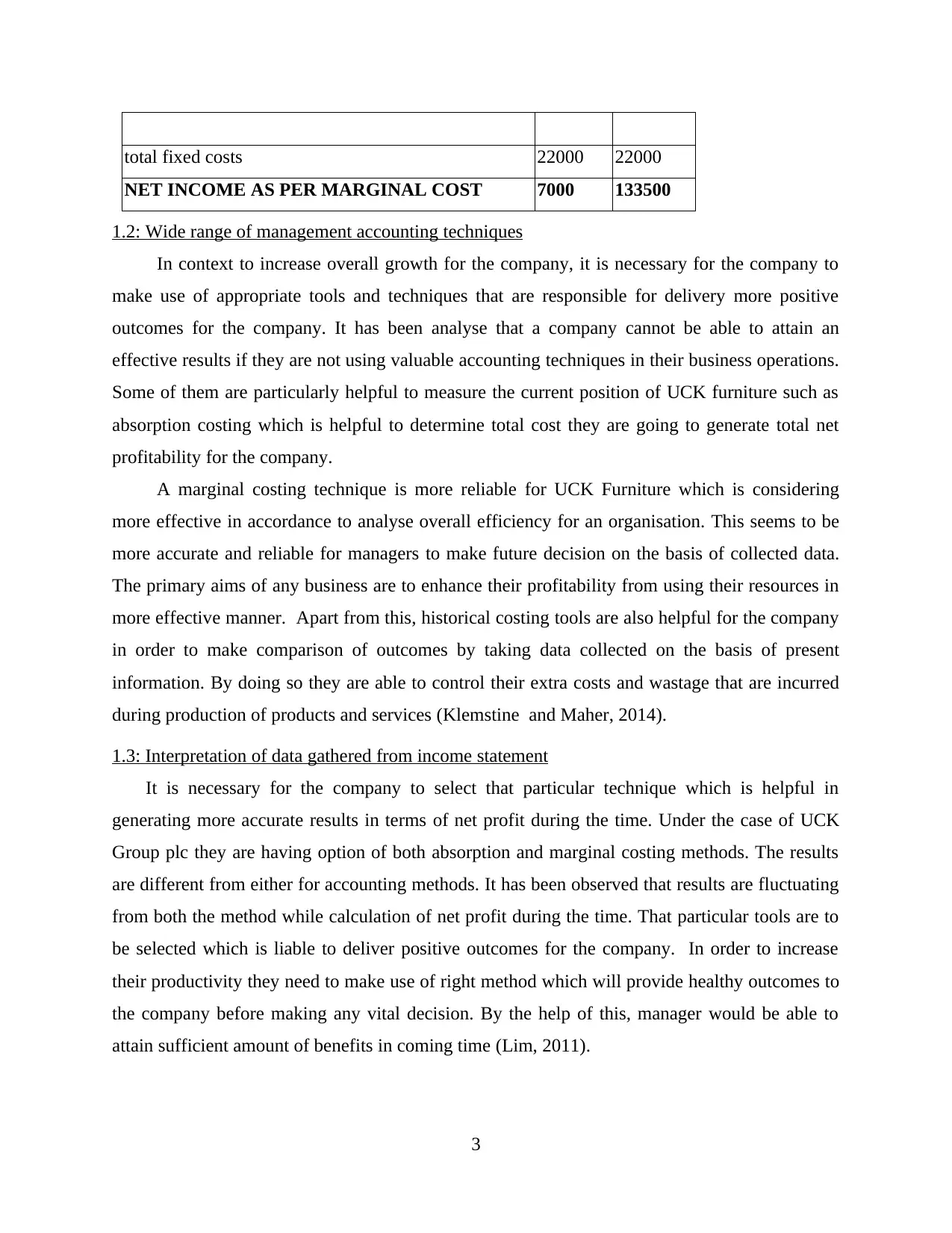
total fixed costs 22000 22000
NET INCOME AS PER MARGINAL COST 7000 133500
1.2: Wide range of management accounting techniques
In context to increase overall growth for the company, it is necessary for the company to
make use of appropriate tools and techniques that are responsible for delivery more positive
outcomes for the company. It has been analyse that a company cannot be able to attain an
effective results if they are not using valuable accounting techniques in their business operations.
Some of them are particularly helpful to measure the current position of UCK furniture such as
absorption costing which is helpful to determine total cost they are going to generate total net
profitability for the company.
A marginal costing technique is more reliable for UCK Furniture which is considering
more effective in accordance to analyse overall efficiency for an organisation. This seems to be
more accurate and reliable for managers to make future decision on the basis of collected data.
The primary aims of any business are to enhance their profitability from using their resources in
more effective manner. Apart from this, historical costing tools are also helpful for the company
in order to make comparison of outcomes by taking data collected on the basis of present
information. By doing so they are able to control their extra costs and wastage that are incurred
during production of products and services (Klemstine and Maher, 2014).
1.3: Interpretation of data gathered from income statement
It is necessary for the company to select that particular technique which is helpful in
generating more accurate results in terms of net profit during the time. Under the case of UCK
Group plc they are having option of both absorption and marginal costing methods. The results
are different from either for accounting methods. It has been observed that results are fluctuating
from both the method while calculation of net profit during the time. That particular tools are to
be selected which is liable to deliver positive outcomes for the company. In order to increase
their productivity they need to make use of right method which will provide healthy outcomes to
the company before making any vital decision. By the help of this, manager would be able to
attain sufficient amount of benefits in coming time (Lim, 2011).
3
NET INCOME AS PER MARGINAL COST 7000 133500
1.2: Wide range of management accounting techniques
In context to increase overall growth for the company, it is necessary for the company to
make use of appropriate tools and techniques that are responsible for delivery more positive
outcomes for the company. It has been analyse that a company cannot be able to attain an
effective results if they are not using valuable accounting techniques in their business operations.
Some of them are particularly helpful to measure the current position of UCK furniture such as
absorption costing which is helpful to determine total cost they are going to generate total net
profitability for the company.
A marginal costing technique is more reliable for UCK Furniture which is considering
more effective in accordance to analyse overall efficiency for an organisation. This seems to be
more accurate and reliable for managers to make future decision on the basis of collected data.
The primary aims of any business are to enhance their profitability from using their resources in
more effective manner. Apart from this, historical costing tools are also helpful for the company
in order to make comparison of outcomes by taking data collected on the basis of present
information. By doing so they are able to control their extra costs and wastage that are incurred
during production of products and services (Klemstine and Maher, 2014).
1.3: Interpretation of data gathered from income statement
It is necessary for the company to select that particular technique which is helpful in
generating more accurate results in terms of net profit during the time. Under the case of UCK
Group plc they are having option of both absorption and marginal costing methods. The results
are different from either for accounting methods. It has been observed that results are fluctuating
from both the method while calculation of net profit during the time. That particular tools are to
be selected which is liable to deliver positive outcomes for the company. In order to increase
their productivity they need to make use of right method which will provide healthy outcomes to
the company before making any vital decision. By the help of this, manager would be able to
attain sufficient amount of benefits in coming time (Lim, 2011).
3
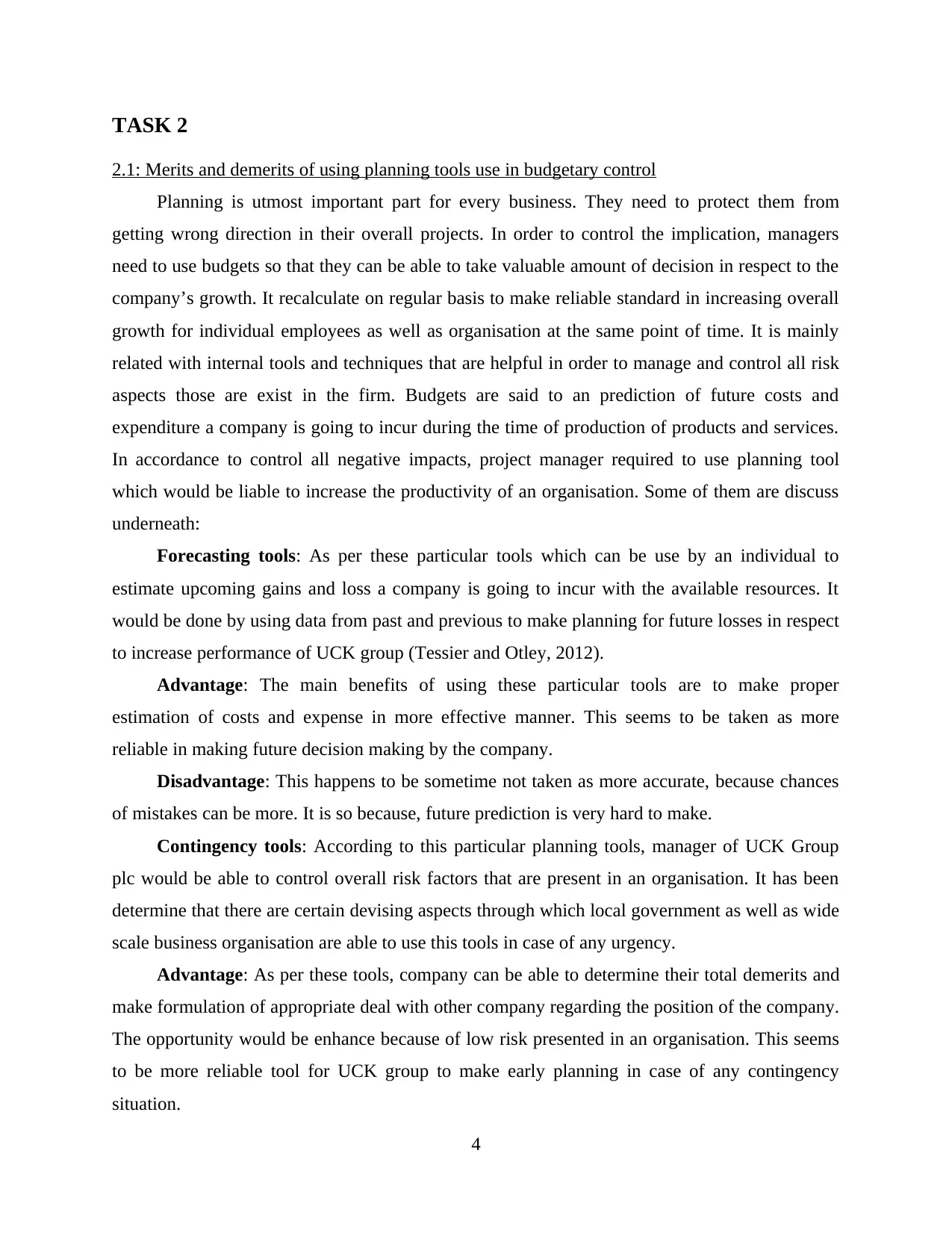
TASK 2
2.1: Merits and demerits of using planning tools use in budgetary control
Planning is utmost important part for every business. They need to protect them from
getting wrong direction in their overall projects. In order to control the implication, managers
need to use budgets so that they can be able to take valuable amount of decision in respect to the
company’s growth. It recalculate on regular basis to make reliable standard in increasing overall
growth for individual employees as well as organisation at the same point of time. It is mainly
related with internal tools and techniques that are helpful in order to manage and control all risk
aspects those are exist in the firm. Budgets are said to an prediction of future costs and
expenditure a company is going to incur during the time of production of products and services.
In accordance to control all negative impacts, project manager required to use planning tool
which would be liable to increase the productivity of an organisation. Some of them are discuss
underneath:
Forecasting tools: As per these particular tools which can be use by an individual to
estimate upcoming gains and loss a company is going to incur with the available resources. It
would be done by using data from past and previous to make planning for future losses in respect
to increase performance of UCK group (Tessier and Otley, 2012).
Advantage: The main benefits of using these particular tools are to make proper
estimation of costs and expense in more effective manner. This seems to be taken as more
reliable in making future decision making by the company.
Disadvantage: This happens to be sometime not taken as more accurate, because chances
of mistakes can be more. It is so because, future prediction is very hard to make.
Contingency tools: According to this particular planning tools, manager of UCK Group
plc would be able to control overall risk factors that are present in an organisation. It has been
determine that there are certain devising aspects through which local government as well as wide
scale business organisation are able to use this tools in case of any urgency.
Advantage: As per these tools, company can be able to determine their total demerits and
make formulation of appropriate deal with other company regarding the position of the company.
The opportunity would be enhance because of low risk presented in an organisation. This seems
to be more reliable tool for UCK group to make early planning in case of any contingency
situation.
4
2.1: Merits and demerits of using planning tools use in budgetary control
Planning is utmost important part for every business. They need to protect them from
getting wrong direction in their overall projects. In order to control the implication, managers
need to use budgets so that they can be able to take valuable amount of decision in respect to the
company’s growth. It recalculate on regular basis to make reliable standard in increasing overall
growth for individual employees as well as organisation at the same point of time. It is mainly
related with internal tools and techniques that are helpful in order to manage and control all risk
aspects those are exist in the firm. Budgets are said to an prediction of future costs and
expenditure a company is going to incur during the time of production of products and services.
In accordance to control all negative impacts, project manager required to use planning tool
which would be liable to increase the productivity of an organisation. Some of them are discuss
underneath:
Forecasting tools: As per these particular tools which can be use by an individual to
estimate upcoming gains and loss a company is going to incur with the available resources. It
would be done by using data from past and previous to make planning for future losses in respect
to increase performance of UCK group (Tessier and Otley, 2012).
Advantage: The main benefits of using these particular tools are to make proper
estimation of costs and expense in more effective manner. This seems to be taken as more
reliable in making future decision making by the company.
Disadvantage: This happens to be sometime not taken as more accurate, because chances
of mistakes can be more. It is so because, future prediction is very hard to make.
Contingency tools: According to this particular planning tools, manager of UCK Group
plc would be able to control overall risk factors that are present in an organisation. It has been
determine that there are certain devising aspects through which local government as well as wide
scale business organisation are able to use this tools in case of any urgency.
Advantage: As per these tools, company can be able to determine their total demerits and
make formulation of appropriate deal with other company regarding the position of the company.
The opportunity would be enhance because of low risk presented in an organisation. This seems
to be more reliable tool for UCK group to make early planning in case of any contingency
situation.
4
⊘ This is a preview!⊘
Do you want full access?
Subscribe today to unlock all pages.

Trusted by 1+ million students worldwide
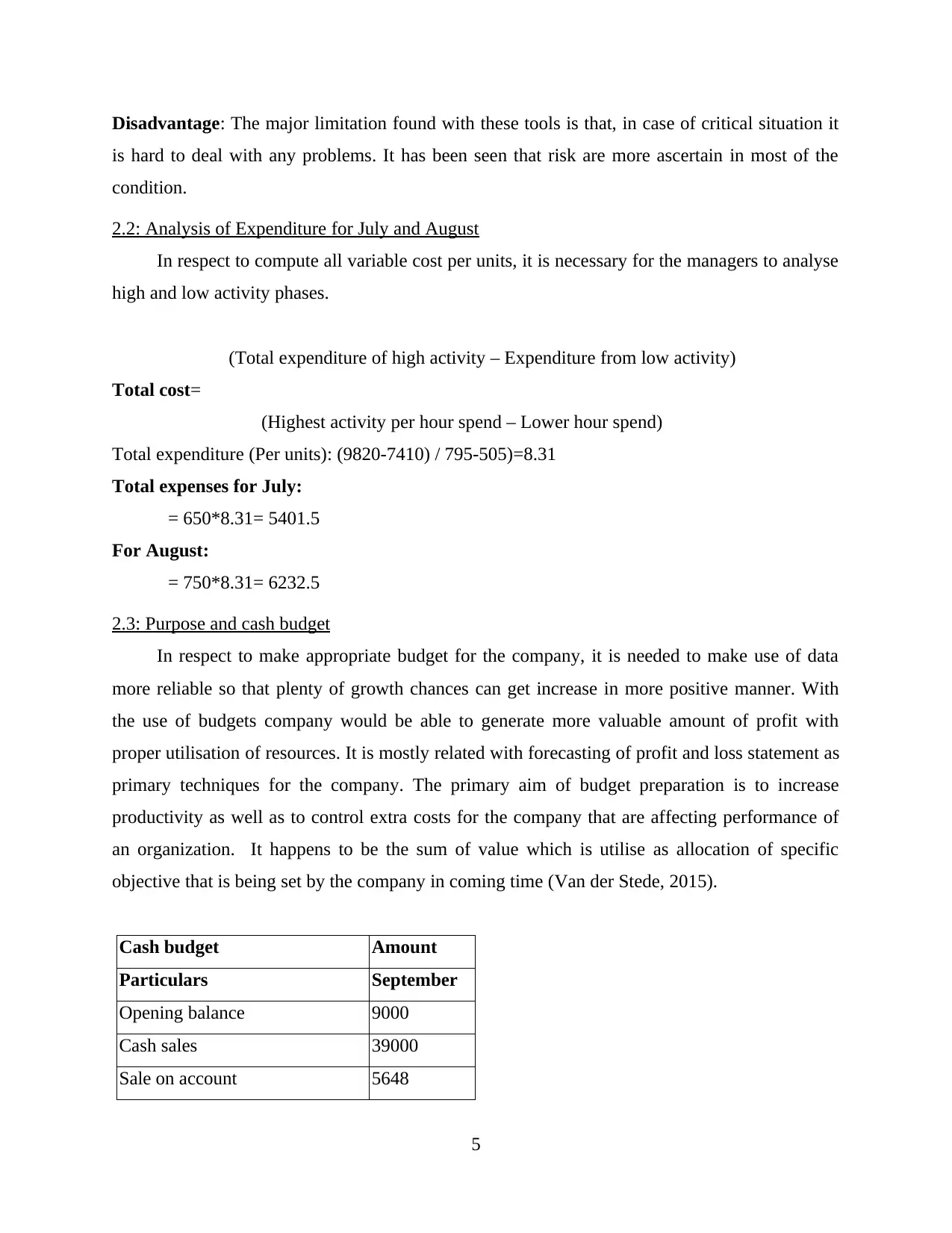
Disadvantage: The major limitation found with these tools is that, in case of critical situation it
is hard to deal with any problems. It has been seen that risk are more ascertain in most of the
condition.
2.2: Analysis of Expenditure for July and August
In respect to compute all variable cost per units, it is necessary for the managers to analyse
high and low activity phases.
(Total expenditure of high activity – Expenditure from low activity)
Total cost=
(Highest activity per hour spend – Lower hour spend)
Total expenditure (Per units): (9820-7410) / 795-505)=8.31
Total expenses for July:
= 650*8.31= 5401.5
For August:
= 750*8.31= 6232.5
2.3: Purpose and cash budget
In respect to make appropriate budget for the company, it is needed to make use of data
more reliable so that plenty of growth chances can get increase in more positive manner. With
the use of budgets company would be able to generate more valuable amount of profit with
proper utilisation of resources. It is mostly related with forecasting of profit and loss statement as
primary techniques for the company. The primary aim of budget preparation is to increase
productivity as well as to control extra costs for the company that are affecting performance of
an organization. It happens to be the sum of value which is utilise as allocation of specific
objective that is being set by the company in coming time (Van der Stede, 2015).
Cash budget Amount
Particulars September
Opening balance 9000
Cash sales 39000
Sale on account 5648
5
is hard to deal with any problems. It has been seen that risk are more ascertain in most of the
condition.
2.2: Analysis of Expenditure for July and August
In respect to compute all variable cost per units, it is necessary for the managers to analyse
high and low activity phases.
(Total expenditure of high activity – Expenditure from low activity)
Total cost=
(Highest activity per hour spend – Lower hour spend)
Total expenditure (Per units): (9820-7410) / 795-505)=8.31
Total expenses for July:
= 650*8.31= 5401.5
For August:
= 750*8.31= 6232.5
2.3: Purpose and cash budget
In respect to make appropriate budget for the company, it is needed to make use of data
more reliable so that plenty of growth chances can get increase in more positive manner. With
the use of budgets company would be able to generate more valuable amount of profit with
proper utilisation of resources. It is mostly related with forecasting of profit and loss statement as
primary techniques for the company. The primary aim of budget preparation is to increase
productivity as well as to control extra costs for the company that are affecting performance of
an organization. It happens to be the sum of value which is utilise as allocation of specific
objective that is being set by the company in coming time (Van der Stede, 2015).
Cash budget Amount
Particulars September
Opening balance 9000
Cash sales 39000
Sale on account 5648
5
Paraphrase This Document
Need a fresh take? Get an instant paraphrase of this document with our AI Paraphraser
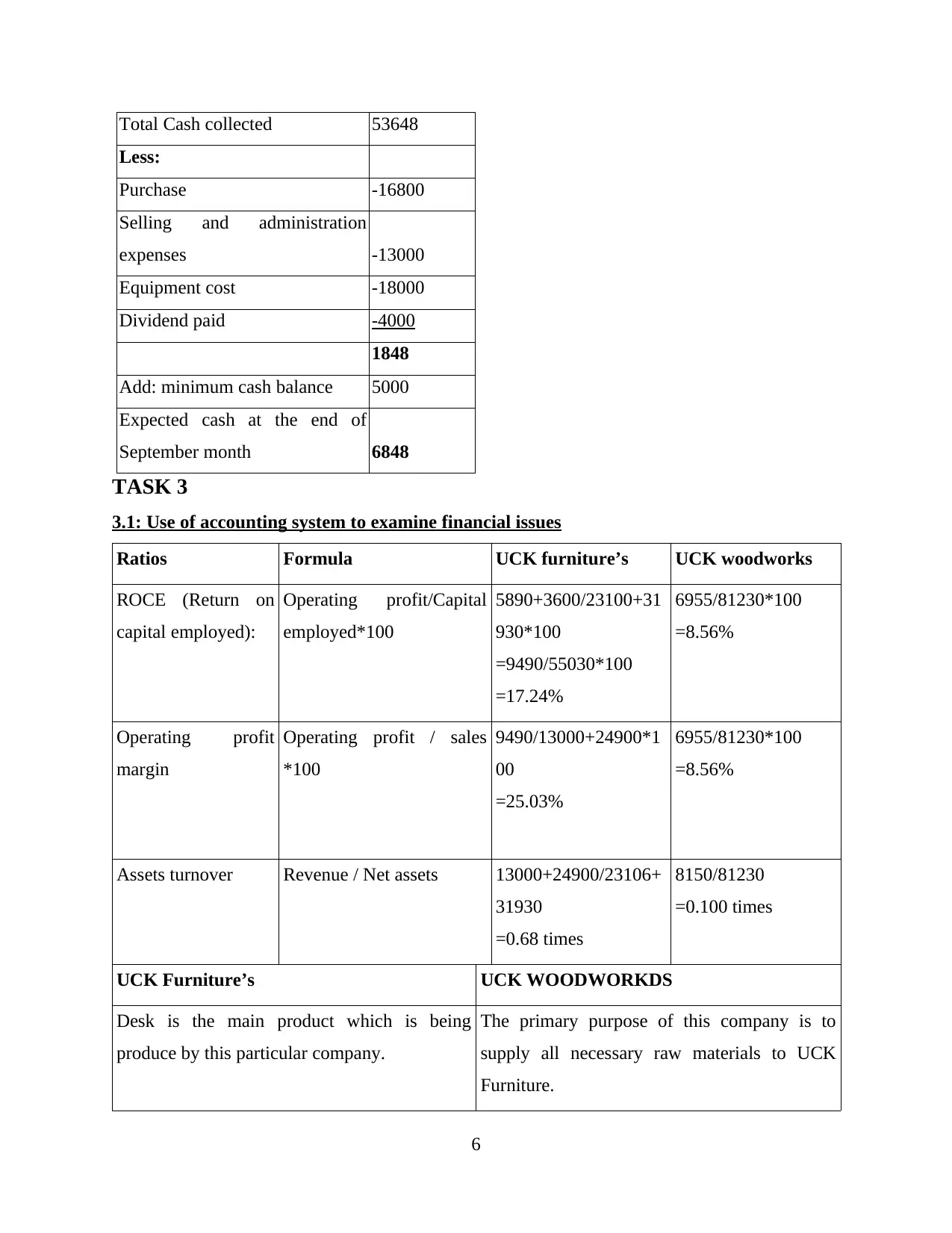
Total Cash collected 53648
Less:
Purchase -16800
Selling and administration
expenses -13000
Equipment cost -18000
Dividend paid -4000
1848
Add: minimum cash balance 5000
Expected cash at the end of
September month 6848
TASK 3
3.1: Use of accounting system to examine financial issues
Ratios Formula UCK furniture’s UCK woodworks
ROCE (Return on
capital employed):
Operating profit/Capital
employed*100
5890+3600/23100+31
930*100
=9490/55030*100
=17.24%
6955/81230*100
=8.56%
Operating profit
margin
Operating profit / sales
*100
9490/13000+24900*1
00
=25.03%
6955/81230*100
=8.56%
Assets turnover Revenue / Net assets 13000+24900/23106+
31930
=0.68 times
8150/81230
=0.100 times
UCK Furniture’s UCK WOODWORKDS
Desk is the main product which is being
produce by this particular company.
The primary purpose of this company is to
supply all necessary raw materials to UCK
Furniture.
6
Less:
Purchase -16800
Selling and administration
expenses -13000
Equipment cost -18000
Dividend paid -4000
1848
Add: minimum cash balance 5000
Expected cash at the end of
September month 6848
TASK 3
3.1: Use of accounting system to examine financial issues
Ratios Formula UCK furniture’s UCK woodworks
ROCE (Return on
capital employed):
Operating profit/Capital
employed*100
5890+3600/23100+31
930*100
=9490/55030*100
=17.24%
6955/81230*100
=8.56%
Operating profit
margin
Operating profit / sales
*100
9490/13000+24900*1
00
=25.03%
6955/81230*100
=8.56%
Assets turnover Revenue / Net assets 13000+24900/23106+
31930
=0.68 times
8150/81230
=0.100 times
UCK Furniture’s UCK WOODWORKDS
Desk is the main product which is being
produce by this particular company.
The primary purpose of this company is to
supply all necessary raw materials to UCK
Furniture.
6
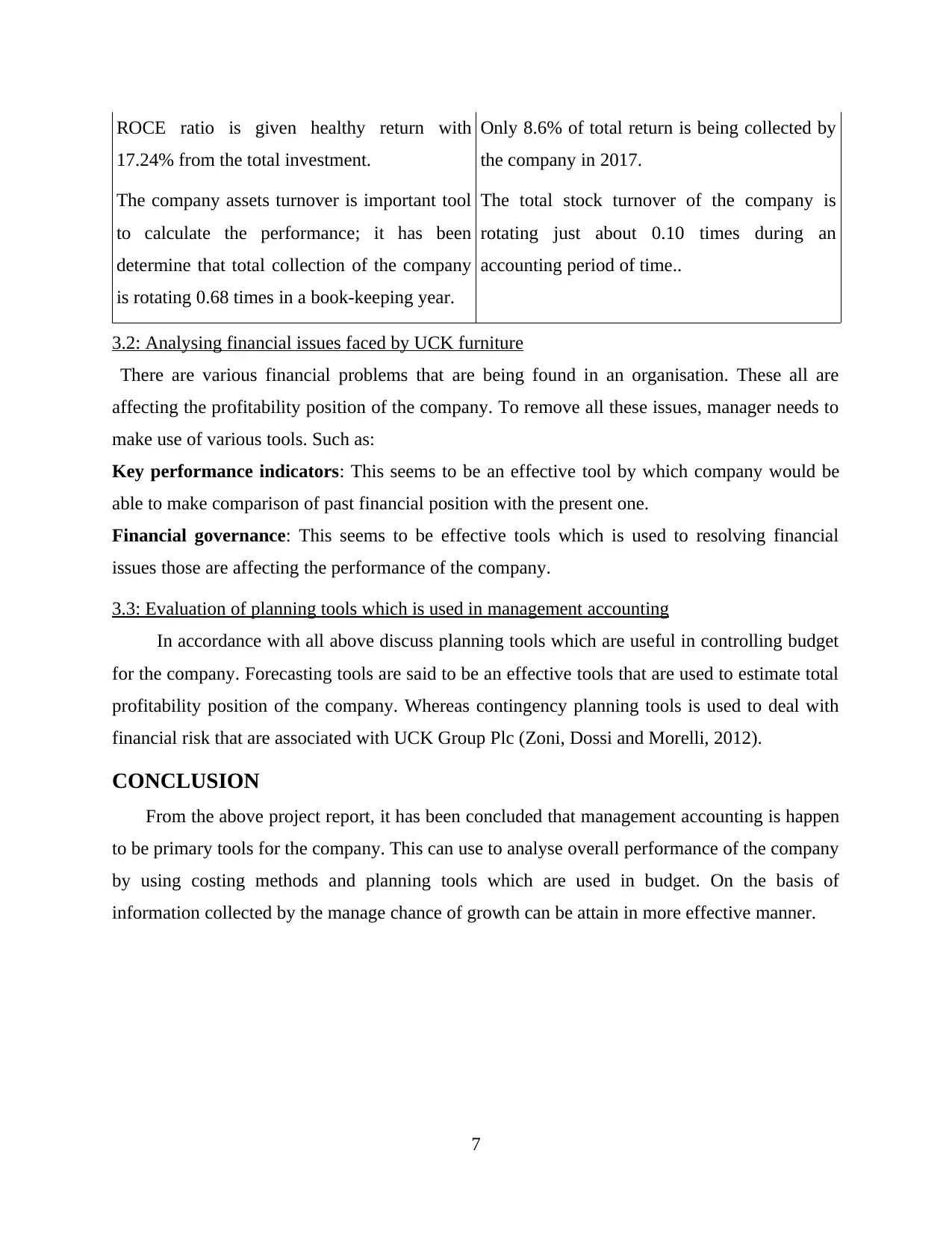
ROCE ratio is given healthy return with
17.24% from the total investment.
Only 8.6% of total return is being collected by
the company in 2017.
The company assets turnover is important tool
to calculate the performance; it has been
determine that total collection of the company
is rotating 0.68 times in a book-keeping year.
The total stock turnover of the company is
rotating just about 0.10 times during an
accounting period of time..
3.2: Analysing financial issues faced by UCK furniture
There are various financial problems that are being found in an organisation. These all are
affecting the profitability position of the company. To remove all these issues, manager needs to
make use of various tools. Such as:
Key performance indicators: This seems to be an effective tool by which company would be
able to make comparison of past financial position with the present one.
Financial governance: This seems to be effective tools which is used to resolving financial
issues those are affecting the performance of the company.
3.3: Evaluation of planning tools which is used in management accounting
In accordance with all above discuss planning tools which are useful in controlling budget
for the company. Forecasting tools are said to be an effective tools that are used to estimate total
profitability position of the company. Whereas contingency planning tools is used to deal with
financial risk that are associated with UCK Group Plc (Zoni, Dossi and Morelli, 2012).
CONCLUSION
From the above project report, it has been concluded that management accounting is happen
to be primary tools for the company. This can use to analyse overall performance of the company
by using costing methods and planning tools which are used in budget. On the basis of
information collected by the manage chance of growth can be attain in more effective manner.
7
17.24% from the total investment.
Only 8.6% of total return is being collected by
the company in 2017.
The company assets turnover is important tool
to calculate the performance; it has been
determine that total collection of the company
is rotating 0.68 times in a book-keeping year.
The total stock turnover of the company is
rotating just about 0.10 times during an
accounting period of time..
3.2: Analysing financial issues faced by UCK furniture
There are various financial problems that are being found in an organisation. These all are
affecting the profitability position of the company. To remove all these issues, manager needs to
make use of various tools. Such as:
Key performance indicators: This seems to be an effective tool by which company would be
able to make comparison of past financial position with the present one.
Financial governance: This seems to be effective tools which is used to resolving financial
issues those are affecting the performance of the company.
3.3: Evaluation of planning tools which is used in management accounting
In accordance with all above discuss planning tools which are useful in controlling budget
for the company. Forecasting tools are said to be an effective tools that are used to estimate total
profitability position of the company. Whereas contingency planning tools is used to deal with
financial risk that are associated with UCK Group Plc (Zoni, Dossi and Morelli, 2012).
CONCLUSION
From the above project report, it has been concluded that management accounting is happen
to be primary tools for the company. This can use to analyse overall performance of the company
by using costing methods and planning tools which are used in budget. On the basis of
information collected by the manage chance of growth can be attain in more effective manner.
7
⊘ This is a preview!⊘
Do you want full access?
Subscribe today to unlock all pages.

Trusted by 1+ million students worldwide
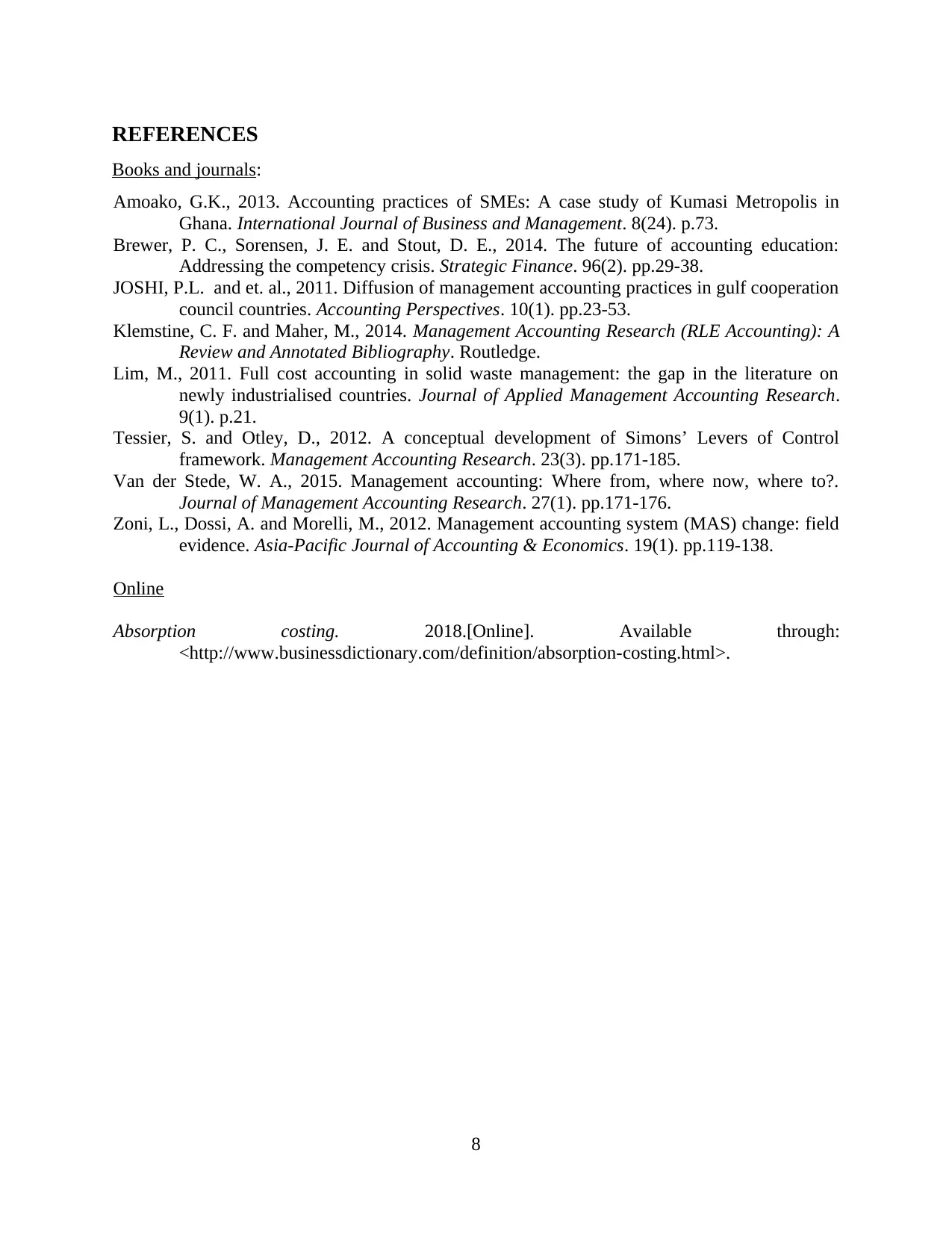
REFERENCES
Books and journals:
Amoako, G.K., 2013. Accounting practices of SMEs: A case study of Kumasi Metropolis in
Ghana. International Journal of Business and Management. 8(24). p.73.
Brewer, P. C., Sorensen, J. E. and Stout, D. E., 2014. The future of accounting education:
Addressing the competency crisis. Strategic Finance. 96(2). pp.29-38.
JOSHI, P.L. and et. al., 2011. Diffusion of management accounting practices in gulf cooperation
council countries. Accounting Perspectives. 10(1). pp.23-53.
Klemstine, C. F. and Maher, M., 2014. Management Accounting Research (RLE Accounting): A
Review and Annotated Bibliography. Routledge.
Lim, M., 2011. Full cost accounting in solid waste management: the gap in the literature on
newly industrialised countries. Journal of Applied Management Accounting Research.
9(1). p.21.
Tessier, S. and Otley, D., 2012. A conceptual development of Simons’ Levers of Control
framework. Management Accounting Research. 23(3). pp.171-185.
Van der Stede, W. A., 2015. Management accounting: Where from, where now, where to?.
Journal of Management Accounting Research. 27(1). pp.171-176.
Zoni, L., Dossi, A. and Morelli, M., 2012. Management accounting system (MAS) change: field
evidence. Asia-Pacific Journal of Accounting & Economics. 19(1). pp.119-138.
Online
Absorption costing. 2018.[Online]. Available through:
<http://www.businessdictionary.com/definition/absorption-costing.html>.
8
Books and journals:
Amoako, G.K., 2013. Accounting practices of SMEs: A case study of Kumasi Metropolis in
Ghana. International Journal of Business and Management. 8(24). p.73.
Brewer, P. C., Sorensen, J. E. and Stout, D. E., 2014. The future of accounting education:
Addressing the competency crisis. Strategic Finance. 96(2). pp.29-38.
JOSHI, P.L. and et. al., 2011. Diffusion of management accounting practices in gulf cooperation
council countries. Accounting Perspectives. 10(1). pp.23-53.
Klemstine, C. F. and Maher, M., 2014. Management Accounting Research (RLE Accounting): A
Review and Annotated Bibliography. Routledge.
Lim, M., 2011. Full cost accounting in solid waste management: the gap in the literature on
newly industrialised countries. Journal of Applied Management Accounting Research.
9(1). p.21.
Tessier, S. and Otley, D., 2012. A conceptual development of Simons’ Levers of Control
framework. Management Accounting Research. 23(3). pp.171-185.
Van der Stede, W. A., 2015. Management accounting: Where from, where now, where to?.
Journal of Management Accounting Research. 27(1). pp.171-176.
Zoni, L., Dossi, A. and Morelli, M., 2012. Management accounting system (MAS) change: field
evidence. Asia-Pacific Journal of Accounting & Economics. 19(1). pp.119-138.
Online
Absorption costing. 2018.[Online]. Available through:
<http://www.businessdictionary.com/definition/absorption-costing.html>.
8
1 out of 10
Related Documents
Your All-in-One AI-Powered Toolkit for Academic Success.
+13062052269
info@desklib.com
Available 24*7 on WhatsApp / Email
![[object Object]](/_next/static/media/star-bottom.7253800d.svg)
Unlock your academic potential
Copyright © 2020–2025 A2Z Services. All Rights Reserved. Developed and managed by ZUCOL.





